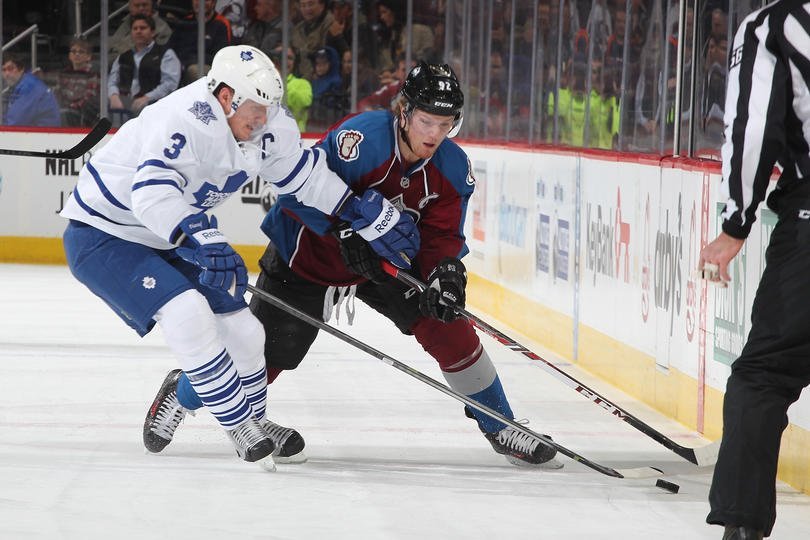As the Toronto Maple Leafs skip along to their first playoff berth in eight seasons, Dion Phaneuf’s play is forcing his name to be included in discussion for the Norris Trophy. The Norris is awarded annually to “the defense player who demonstrates throughout the season the greatest all-round ability in the position,” and that sure sounds like the play of the Leaf captain this season.
He plays a physical, two-way brand of hockey and sits fifth-best in league for defensemen scoring with eight goals and 18 assists for 26 points in 42 games. He’s a leader on the ice, the best defender on the team by a mile and has joined forces with Phil Kessel, Nazem Kadri and James Reimer to drag the Leafs into contention.
But how does his performance this season stack up against performances past, and what greater truths can we find about the anatomy of a Norris Nominee?
To get a sense of that, I put together the table below with my selections for the Norris Trophy voting for 2013, along with the past five years’ worth of Norris Trophy nominees (with Phaneuf and the trophy winners’ stat lines bolded for ease of reading).
I took a look at few performance metrics from www.behindthenet.ca as well as some more traditional ice time and scoring numbers to attempt to get a holistic view of Norris-calibre players. I also included a brief legend to aid understanding for the still-burgeoning statheads in Leafs Nation.
Relative Corsi Quality of Competition (Corsi Rel QoC) is a statistical metric that measures the value of an individual player’s opposition. The higher the number indicates the higher quality of opponent a player faces on the ice.
Relative Corsi Quality of Teammates (Corsi Rel QoT) is a metric similar to Corsi rel QoC, in that it measures the quality of an individual player’s teammates. A higher score denotes better quality teammates measured against their own play.
PDO is the sum of a player’s on-ice save percentage and shooting percentage. It helps to measure ‘puck luck’ and is useful when discussing exceptional play. Numbers above 1000 generally suggest a player is getting fortuitous bounces.
Ranks found in the Corsi Rel QoC/QoT are based off of 30 games played in the 2013 season, and 60 games played in all other seasons.
You can go here for a glossary of terms for the above stats
Norris Trophy Winner Statistics
| Name | Year | pts per game | Corsi Rel QOC (rank) | Corsi Rel QOT (rank) | TOI/G | PPTOI/G | PKTOI/G | OZone Starts | PDO |
|---|---|---|---|---|---|---|---|---|---|
| Dion Phaneuf | 2013 | 0.62 | 2.105 (2nd) | -1.181 (137th) | 25:33 | 3:25 | 3:05 | 40.9% | 1029 |
| P.K. Subban | 2013 | 1 | 0.013 (100th) | -0.294 (118th) | 23:12 | 4:25 | 1:36 | 52.8% | 1013 |
| Ryan Suter | 2013 | 0.74 | 0.969 (26th) | 2.678 (8th) | 27:11 | 3:57 | 2:19 | 48.7% | 1010 |
| Erik Karlsson | 2012 | 0.96 | 0.657 (64th) | 0.301 (83rd) | 25:19 | 3:53 | 0:33 | 57.1% | 1013 |
| Zdeno Chara | 2012 | 0.66 | 1.015 (32nd) | 3.314 (5th) | 25:00 | 2:39 | 2:43 | 48.1% | 1010 |
| Shea Weber | 2012 | 0.63 | 1.332 (12th) | 1.462 (27th) | 26:09 | 3:31 | 2:16 | 44.6% | 1021 |
| Nick Lidstrom | 2011 | 0.76 | 1.807 (1st) | -1.080 (135th) | 23:28 | 4:03 | 2:40 | 48.8% | 1002 |
| Zdeno Chara | 2011 | 0.54 | 1.047 (15th) | 2.220 (9th) | 25:26 | 3:08 | 2:48 | 45.6% | 1030 |
| Shea Weber | 2011 | 0.59 | 0.942 (19th) | 1.890 (13th) | 25:19 | 3:38 | 2:06 | 45.3% | 1006 |
| Duncan Keith | 2010 | 0.84 | 1.405 (5th) | -0.690 (139th) | 26:35 | 2:48 | 2:58 | 52.4% | 979 |
| Mike Green | 2010 | 1.01 | 0.112 (96th) | 2.114 (7th) | 25:28 | 5:03 | 2:09 | 57.4% | 1058 |
| Drew Doughty | 2010 | 0.72 | 0.932 (29th) | 0.072 (106th) | 24:58 | 4:25 | 2:01 | 56.2% | 1010 |
| Zdeno Chara | 2009 | 0.62 | 1.159 (14th) | -0.557 (132nd) | 26:04 | 3:46 | 3:21 | 45.9% | 1023 |
| Nick Lidstrom | 2009 | 0.76 | 1.614 (2nd) | 3.962 (1st) | 24:49 | 3:55 | 3:27 | 51.1% | 1015 |
| Mike Green | 2009 | 1.03 | - 0.108 (117th) | 1.217 (38th) | 25:45 | 5:22 | 2:28 | 62.2% | 1021 |
| Nick Lidstrom | 2008 | 0.92 | 1.209 (18th) | 4.529 (2nd) | 26:43 | 4:43 | 3:57 | 56.8% | 1034 |
| Zdeno Chara | 2008 | 0.66 | 1.048 (27th) | 1.324 (37th) | 26:50 | 4:20 | 3:37 | 48.6% | 1017 |
| Dion Phaneuf | 2008 | 0.73 | 0.157 (99th) | 3.073 (4th) | 26:25 | 5:02 | 2:48 | 56.8% | 1013 |
So what is the anatomy of a Norris candidate and winner? Here are some takeaways from the above table:
- Norris nominated defensemen are generally playing about 25+ minutes a night on playoff teams, feature heavily on the power play and at least regularly on the penalty kill, while scoring 45+ points in an 82-game season (0.54 points per game).
- Minimum requirement of 4:00 minutes of special teams time on ice per night, although Nik Lidstrom did manage almost 9:00 minutes a night when he won in 2008.
- Norris winners typically score at 0.70 points per game pace or better, suggesting that dominant offense plays a large role in determining eligibility.
- Ideal Norris-calibre PDO score? About 1010. Lucky, but not too lucky.
- The Norris winner typically ranks highly in Corsi rel QOC. This makes sense; because the league’s best defenseman ought to play against the hardest competition in the hardest situations. Erik Karlsson was a notable exception to this rule, because…
- The award praises exceptionality by a defenseman, even at the expense of good defense. Offensive exceptionality will suffice to make up for poorer competition numbers, high offensive zone starts (which encourage better offensive numbers), and a high PDO. Mike Green came second in Norris voting in consecutive seasons probably because he was getting five minutes of ice time a game on a then-stellar Washington power play. Nonetheless, offensive gaudy numbers draw attention.
- Many Norris nominees benefitted from playing with some pretty terrific teammates. Would Shea Weber have put up so many points had he not been paired with Ryan Suter? Nik Lidstrom always did have Brian Rafalski, right?
- However, Norris winners appeared to have some of the worst teammates relative to their own play. There appears to be an on-going trend in the past four seasons where the Norris winner will have the lowest Relative Corsi Quality of Teammates of the nominees, very often among the league-worst scores in the category.
- Most interestingly, this suggests that Norris voters – whether consciously or not – tend to vote for players who perform admirably alongside weaker linemates. I should state that this isn’t predictive, as Nik Lidstrom won his Norris Trophy in 2008 with the league’s second best Corsi rel QOT.
Quickly, I’d like to explain my selections and the notable omissions from the 2013 list. PK Subban is a very good bet to get nominated, as his dominant offensive performance makes him noticeable. He’s very unlikely to win with numbers mirroring Mike Green’s, but he stands out enough to be recognized. He’s still on pace for an impressive 25 goals in an 82-game season.
Ryan Suter will represent the west, because somebody has to. Were Oliver Ekman-Larsson on a playoff team, or Kronwall’s box cars a bit higher, some of their advanced numbers would warrant much more consideration than Suter for nomination. But it falls on Suter, who has otherwise has put together a great-but-not-outstanding season with the Minnesota Wild.
Kris Letang could get a nomination based off of his tremendous play this year, but has missed a quarter of the season with three separate injuries. That only accounts for 12 total games missed, but it’s enough to sink his chances in a shortened season. Had this been an 82-game season, he could sneak in with 70 games played, but only 36 of 48 games probably excludes him from contention.
So with all that in mind, how does Dion Phaneuf stack up in the hearts and minds of Norris Trophy voters?
Well enough by the numbers to at least get nominated, and with a slight uptick in offense he could be a real contender for the Norris Trophy. He’s facing the second most difficult competition by a defenseman in the league at even strength. He plays over three minutes a night each on the PK and PP, spending about 25% of his nightly ice time on special teams, proving that you can be a master of all trades.
He toils in these tough minutes while managing a modest, but good-enough 0.62 points per game. A 50-point pace is nothing to scoff at, but it barely warrants a mention when considering the league’s best defenders. Were he to win the Norris, he’d do so with the lowest points per game total since Zdeno Chara, whose 2009 numbers most mirror Phaneuf’s production this season. That said, a scoring streak in the final six games would be a boon to his chances.
But will it be enough for him to win? Impossible to say. To Phaneuf’s credit, this season’s numbers are mostly better than when he was nominated in 2008 on the strength of a 17-goal, 60-point effort. While his offense is way down from then, Phaneuf’s playing fewer, but significantly tougher minutes, with the likes of Mike Kostka and Korbinian Holzer instead of a vintage Robyn Regehr.
Should Phaneuf get nominated in the coming weeks – and he should – it may finally help solidify his place as an elite defender in the NHL. While he’s received more than his share of criticism in his time, a second Norris nomination in an eight-year career is a rare feat by a rare player.

































![Sheldon Keefe Post Game, Leafs 3 vs. Bruins 2: “I loved [the Matthews] line, and I loved a lot about our game all the way through the lineup” Sheldon Keefe, Toronto Maple Leafs post game](https://mapleleafshotstove.com/wp-content/uploads/2024/04/keefe-pg-game-1-100x70.jpg)

